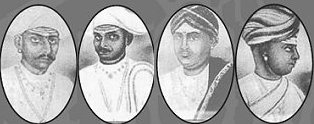Snippets of Information
Dance - Bharatanatyam
Karanas
* 28 Feb 2022
K. P. Kittappa Pillai, a brilliant musician and choreographer
belonging to the traditional community of artists was a fifth-generation
descendant of the illustrious Thanjavur Quartet who are credited with
the codification of adavus and the development of the Bharatanatyam
format. He choreographed the dance for Sarabendra Bhoopala Kuravanji
with Balasaraswati and Alaya Geetavadya Nrityanjali or Navasandhi Stuti.
He set up the dance formats and the Varna Mettu’s for Kalidasa’s Ritu
Samhara in the original Sanskrit and some of the poetic works of Tanjore
ruler Shahaji in Marathi. His remarkable compositions like the
Navasandhi Kavituams remain a jewel in the Bharatanatyam
repertoire. A son of the illustrious vaggeyakara Sangita Kalanidhi
K. Ponniah Pillai and Lakshmi Ammal, he was named Sabhapati; Kittappa
was his pet name. He was also known as K.P. Krishnamurti Pillai. Trained
by Natesa Sastry, grandson of Syama Sastry, in vocal music, he became
skilful in playing the mridangam as well. He learnt the art of
nattuvangam from his maternal grandfather, the illustrious Pandanallur
Meenakshisundaram Pillai (a disciple of Mahadeva Nattuvanar belonging to
the direct lineage of Sivanandam of the Tanjavur Quartet).
Kittappa Pillai initially started out as a vocalist, performing with his
maternal cousin Narayanaswami. After the demise of his cousin, Kittappa
stopped rendering vocal concerts. For sometime he assisted
Meenakshisundaram Pillai who was teaching at Kalakshetra. He
concentrated on teaching the varied aspects of nritta and abhinaya in
Bharatanatyam, doing nattuvangam, and composing jatis. All this
gradually expanded over the years after senior stalwarts of his
paramapara passed away, and Kittappa Pillai became the byword for
nattuvangam and technical excellence in Bharatanatyam. During his career
of four and-a-half decades as an expert dance master conductor
choreographer, he came to be known as a unique teacher of countless
Tanjore compositions, many of which he re-created from memory and close
observation of his own gurus.
Kittappa Pillai’s nritta technique had an inherent musical quality.
Almost every creation was a masterpiece. His rhythmical patterns had a
special touch, often based on ‘usi eduppus’ (commencing off the beat).
Source: sahityakalp.com
- Guru Kittappa's choreography of adavu-s is always in the Madhya laya.
Sometimes he combined it with the chollu-s in drut. His chollu-s form a
beautiful dialogue with the adavu patterns. His teermanam-s,
particularly in varnam, are never too long except the first Trikala
Teermanam.
- He gave a lot of importance to the plain rendering of notes. He did
not advocate unnecessary Bhruga-s or the twisting of words in singing
his Sangati-s in Varnam-s and Padam-s gave utmost importance to words
and emotional content.
- His dance philosophy music came first. He saw the visuals along with
the music. So, whenever he choreographed a pattern into a musical
structure, it blended perfectly into it.- - He used to express his
philosophy of Bharatanatyam choreography in just a few words, “Dance
should be beautiful to see AND to listen.”
Source: GURU K.P. KITTAPPA - A TREASURE HOUSE OF BHARATANATYAM (Natya Kala Conference 2000) by Dr. Sucheta Chapekar, narthaki.com
* 28 Feb 2022
Thanjavur Quartet's house, a historic landmark - situated behind
the western walls of the Brihadeeswara Temple at 1818, West Main Street,
Thanjavur. This house was gifted to my ancestors by Tulaja II,”
says Chandrasekhar, son of Kittappa Pillai (eighth generation of the
Thanjavur nattuvanar family).
Source: The roots of legacy: A visit to Thanjavur Quartet's house, Jagyaseni Chatterjee, Aug 25, 2016, thehindu.com
* 28 Feb 2022
Guru Vadivelu learnt the violin from a Christian priest in the Thanjavur
court. Impressed by his playing of Carnatic kritis on this western
instrument, the Travancore king Swati Tirunal gifted him an ivory violin
in 1834.
Source: The roots of legacy: A visit to Thanjavur Quartet's house, Jagyaseni Chatterjee, Aug 25, 2016, thehindu.com
* 28 Feb 2022
Beginning from Gangaimuthu Nattuvanar, grandfather of the Thanjavur Quartet
and father of Subbarayan, the family has continued its artistic
endeavours, contributing immensely to the field of Bharatanatyam.
Ponnayya was a composer and vocalist, Chinnayya was a choreographer,
Sivanandam, a mridangam vidwan and nattuvanar, and Vadivelu was a
composer and violinist.
Source: The roots of legacy: A visit to Thanjavur Quartet's house, Jagyaseni Chatterjee, Aug 25, 2016, thehindu.com
* 16 Aug 2021

Thanjavur Quartet (Thanjai Naalvar in Tamil) refers to Chinnayya
(1802-1856), Ponniah (1804-1864), Sivanandam (1808-1863) and Vadivelu
(1810-1845) - four brothers who codified and systematized the 'SADIR'
format were nattuvanars at the court of Maratha King Serfoji II (1798-1832 A.D.) in the early 19th century.
Descendants of the Thanjavur Quartet
Gurus Meenakshi Sundaram Pillai ; Ponnayya Pillai ; Chokkalingam Pillai ;
Subbaraya Pillai ; Kandappa Pillai ; K.P.Kittappa Pillai ;
K.P.K.Chandrasekharan
|